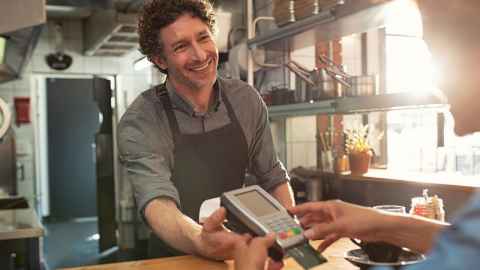Why we should decline the invitation to leave a tip
19 March 2024
Tipping is a big part of the service industry in the United States, but that doesn’t mean we should adopt it, argues Ananish Chaudhuri.

Opinion: New eftpos machines that will automatically prompt customers to leave a 5, 10 or 15 percent tip are being rolled out across New Zealand. Although this is common overseas, particularly in the US, I don’t think it’s time to promote a culture of tipping here.
Why do people tip? While the origin of tipping is disputed, some believe it started in English taverns in the 18th century, where patrons would slip money to the server for faster service, and it has been speculated that the word “tip” is an acronym for the phrase “to insure promptitude”.
These days, however, in countries where there’s a culture of tipping, people leave a tip at the end, rather than the start of the service.
People tip because it’s a social custom, something that’s expected. I lived in the US for many years and the norm was a 15 percent tip. This was pretty much regardless of service. Unless the service was terrible and, in some cases, even then, we left a 15 percent tip. A social norm like this quickly becomes binding, and deviating from it is tantamount to a social faux pas.
Another reason for tipping in the US is that service industry workers’ wages are abysmal in large parts of the country.
This is not true in New Zealand. Our minimum wage, at about $22 per hour, is nearly 70 percent of our median wage at about $32 per hour. This is a far cry from the US.
It’s also not clear to me why some are tipped while others not. Taxi drivers are often tipped but bus drivers are not. Servers in fancy restaurants get tipped while those working in fast food restaurants don’t, even though the demands of the job are probably similar in both locations. Is it because servers in fancy restaurants provide a more personalised service? Should you tip at a relatively fancy place if you get take-out? Do the cooks and cleaners behind the scenes deserve a tip?

The process is often very arbitrary. It’s also not clear if your tip is reaching its intended target. Will it go to the person who took such good care of you, or will it be divided equally among all the workers, both the good and the not-so-good? Will some of it simply add to the establishment’s bottom line and not make its way to the workers at all?
Another issue is the amount we pay to use our cards – there’s often a fee for using a contactless debit card and another for using a credit card. Currently in New Zealand we routinely pay around 2 percent credit card surcharge. So, if a meal costs you $100, you pay $2; if it costs $500 then you pay $10.
Things in Aotearoa are expensive, and it’s not unusual to rack up a bill of a few hundred dollars in a nice restaurant. And these days we are increasingly cashless. This means that if you spend $300 and charge it to your card, you will pay a $6 credit card surcharge. If you leave a 20 percent tip, your bill is now $360, and your surcharge is $7.20. $1.20 more is not a big deal, right?
But remember that the act of adding the tip means that you are now paying your bank an extra $1.20. If a million people do this, that’s $1.2 million dollars. If they do this once a month, this becomes $14.4 million over a year.
In 2023, ANZ reported profits of $2232m, up 10 percent from the previous year, while Kiwibank reported profits of $175m, peanuts compared to ANZ but still up 34 percent from the previous year. Bank profits have skyrocketed, but have their services improved?
In my opinion, we should bring cash if we plan to tip, or simply ignore the tip prompt.
To the extent that tipping is designed to be redistributive – a means of transferring wealth from the well-off to the less well-off – we could instead make a lump-sum contribution to a charity via direct bank transfer to avoid the surcharge.
We can then claim the 33 percent tax benefit that comes from charitable giving.
Ananish Chaudhuri is professor of economics at the University of Auckland and author of the forthcoming book Economics: A Global Introduction.
This article reflects the opinion of the author and not necessarily the views of Waipapa Taumata Rau University of Auckland.
It was first published by Stuff
Media contact
Sophie Boladeras | Media adviser
M: 022 4600 388
E: sophie.boladeras@auckland.ac.nz